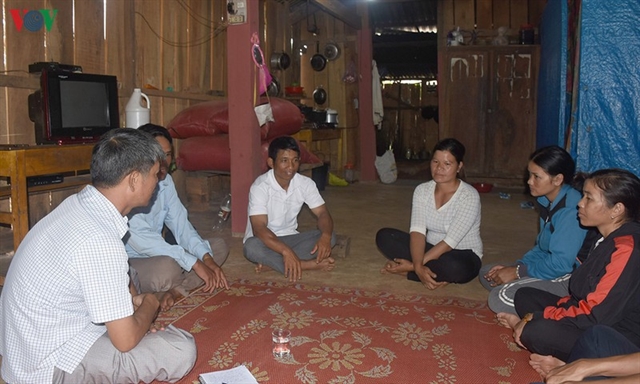 Society
Society


|
| Local authorities of Đăk Trăm Commune visit Y Loan (third right)'s family, who applied for her household to be rid of the poverty status in 2019 in Kon Tum Province. — Photo vov.vn |
KON TUM — Y Loan, a 28-year-old woman, in the Central Highlands province of Kon Tum’s Đăk Tô District, wakes up early every day to tend to her family’s rice fields and other crops.
She and her husband push each other to work hard to escape poverty.
In 2019, she voluntarily applied for her household to no longer be designated as in poverty, saying there were others in greater need of Government support.
The authorities accepted her request.
"I'm young and have good health, so I can do many things to make a better life. I think I should get out of poor household status. A lot of people have it harder than me and they need the Government's support," Loan told the Voice of Vietnam.
Loan’s family was one of the first households to voluntarily ask Đăk Trăm Commune authorities to remove their poor household status.
Poor households are eligible for financial and housing support as well as low-interest loans to invest in their livelihoods, among other forms of support provided by the Government to lift them out of poverty.
In 2019, 83 households voluntarily asked authorities to no longer be designated as poor in Kon Tum Province.
Of which, 21 households were from Đăk Tram Commune, the home of many Xơ Đăng ethnic minority people. Their income is mainly based on agricultural production.
"In the village, there are still many elderly people who have it harder than me. My family is not rich but I think it is enough. I would like to leave the poor household status to give back the support to the more needy households,” said A Thư, 46, a father of 10 children in Đăk Kang Peng Village, Diên Bình Commune.
In this village, many families have 9-10 children and having 5-7 children is considered not many.
Thư's family became a poor household since one of his children suffered from cancer and they had to sell all their property to pay for treatment.
Some of his children also had to drop out of school since then to work on the family farm, Thư said.
"My family received Government support for many years. Now, the children have grown up, some are married. Our economic burden has also decreased. I will try to work hard to have a better life," Thư said.
Many families who rejected poverty status have confirmed the effectiveness of the national target programme on sustainable poverty reduction of the locality, said Trương Đình Tuệ, chairman of the People's Committee of Đăk Trăm Commune.
This showed people are aware of poverty reduction and have tried to improve their production to be able to get out of poverty, Tuệ said.
“This is one of the encouraging signs in implementing the policy of the Party and State on poverty reduction. It also contributes positively in the propaganda and mobilisation of the people in poor and near-poor households to enhance production and economic development," said Tuệ.
Provincial reports show that the households who voluntarily applied to be rid of poverty status had very limited knowledge of agriculture.
Their income has increased by 20- 40 per cent after being supported through production development projects.
Nguyễn Trung Thuận, deputy director of the provincial Department of Labour, Invalids and Social Affairs, said they would suggest the province continue supporting production to help local residents escape poverty.
The provincial poverty rate has reduced from 26.11 per cent in 2015 to 13.62 per cent in 2019.
Kon Tum is expected to achieve the goal of sustainable poverty reduction in 2021-2025 with an annual reduction rate of 3-4 per cent. VNS




